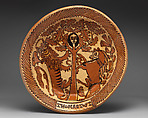Display dish with Charles II (1630–1685) in a tree
There are numerous large dishes from the late seventeenth century inscribed with the name Thomas Toft. This North Staffordshire potter, possibly of Scandinavian origin, used traditional pottery techniques but more ambitiously than any potter up to that time. Here, a white clay slip was applied over the upper surface of the charger; the design was then drawn and filled in with dark brown and orange red clay slips. The honey-colored lead glaze was applied to only this decorated surface, not to the underside, turning the stark white ground a pale yellow and harmonizing with the earth colors of the design. A lion and a unicorn, supporters of the royal coat of arms of England and Scotland, are rampant to each side of a spreading oak tree enclosing a young face by its spreading branches, with the letters "CR," for Charles Rex, below. This reference is to a popular true story that Charles II related to Samuel Pepys in 1680. After his defeat at the battle of Worcester in 1651, the young king climbed into an oak in Boscobel Wood to escape OIiver Cromwell's soldiers, and one of the men passed directly beneath the tree in which he was hiding.
#404. Ceramics and Craftsmanship
Due to rights restrictions, this image cannot be enlarged, viewed at full screen, or downloaded.
This artwork is meant to be viewed from right to left. Scroll left to view more.



